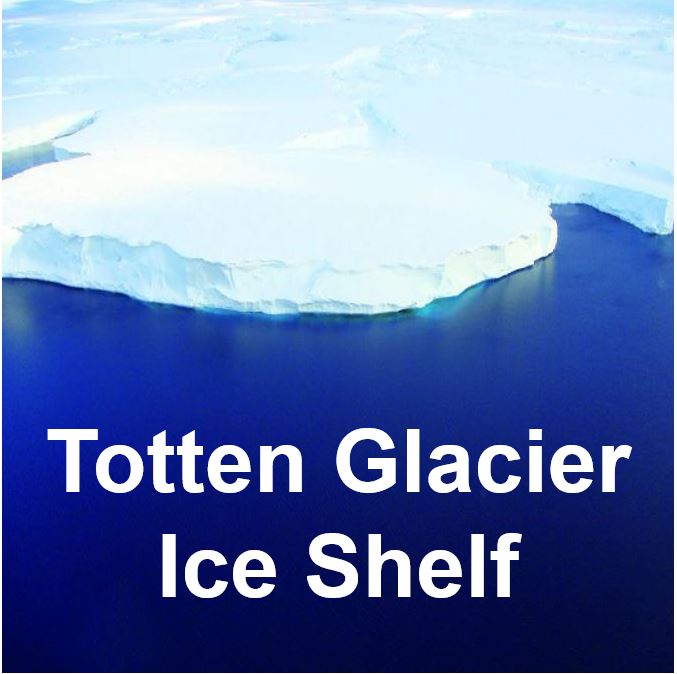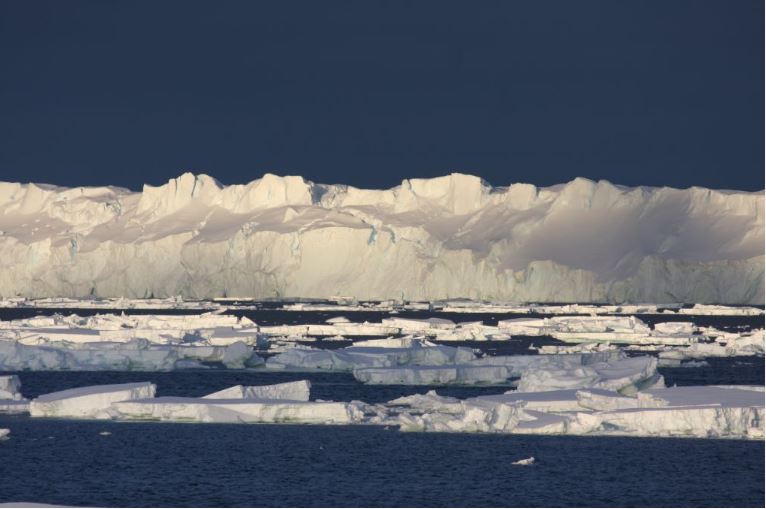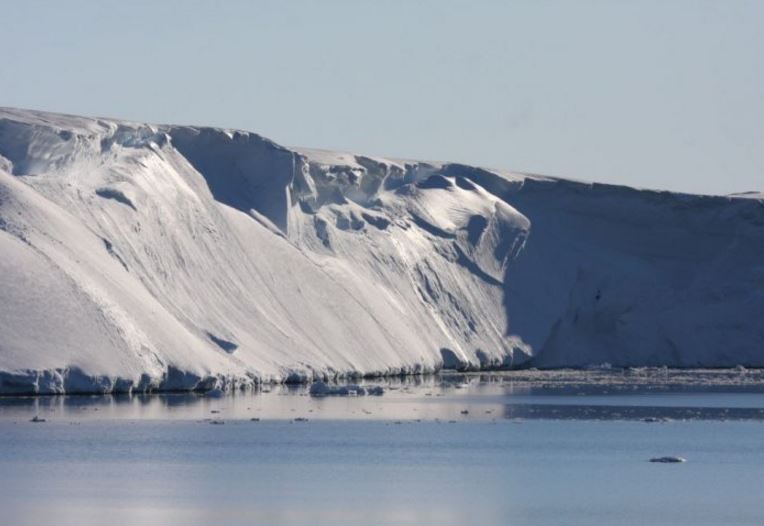The giant Totten Glacier in East Antarctica could melt and lead to a rise in sea level of several metres over the coming centuries – as soon as the retreat reaches a certain point, nobody will be able to stop it – says an international team of scientists from Australia, New Zealand, the US and UK.
Dr Alan Aitken, from the University of Western Australia, and colleagues explained in the journal Nature (citation below) that vulnerabilities deep below the largest ice sheet in the world could lead to a significant increase in sea levels.
Dr. Aitken worked with scientists from the Institute of Geophysics at the University of Western Australia, Victoria University of Wellington in New Zealand, the Institute for Geophysics at the University of Texas at Austin, USA, and Imperial College London in England.
 The calving front of the Totten Glacier ice shelf. If its ice shelf melts, we would be looking at a sea level rise of several metres. (Image: Australian Antarctic Division. Credit: Tas van Ommen)
The calving front of the Totten Glacier ice shelf. If its ice shelf melts, we would be looking at a sea level rise of several metres. (Image: Australian Antarctic Division. Credit: Tas van Ommen)
Totten Glacier – outlet to giant ice catchment
According to glaciologist Dr. Jason Roberts, from the Antarctic Climate & Ecosystems Cooperative Research Centre at the University of Tasmania, the science team looked at the landscape evolution and past history of ice-sheet change of the Totten Glacier, which drains a major portion of the East Antarctic Ice Sheet – it is the outlet for one of the biggest ice catchments in the world.
The authors said their study built on research undertaken last year that discovered pathways for warm ocean reaching a floating portion of the glacier, which could make it vulnerable to retreat.
Dr. Roberts said:
“In this study we used ice-penetrating radar, magnetic and gravity data, to determine the thickness of the ice-sheet and the sediment thickness under the ice sheet, which we then used to map glacial erosion beneath the ice sheet.”
“We found two unstable zones across which the ice sheet appears in the past to have retreated and advanced rapidly. The nature of the bedrock hills and valleys does not provide a stable midway position.”
 The catchment drained by the Totten Glacier is estimated at 538,000 km2. It is a major portion of the East Antarctic Ice Sheet, through the Budd Coast of Wilkes Land in the Australian Antarctic Territory. (Image: Australian Antarctic Division. Credit: Esmee van Wijk)
The catchment drained by the Totten Glacier is estimated at 538,000 km2. It is a major portion of the East Antarctic Ice Sheet, through the Budd Coast of Wilkes Land in the Australian Antarctic Territory. (Image: Australian Antarctic Division. Credit: Esmee van Wijk)
First evidence of instability
Dr. Tas van Ommen, from the Australian Antarctic Division in Tasmania, said that while researchers knew in advance that ice retreat had occurred in this region before, their study was the first to show evidence of instability.
Dr. van Ommen said:
“If the ice retreats further than about 150 km from its present position, it reaches the first of the unstable zones.”
“This would trigger a period of rapid retreat for the glacier, causing it to withdraw over 350 km inland from its current front at the coast. Such an occurrence would contribute more than 2 meters to global sea-level rise.”
Even though a retreat of several hundred kilometres inland is likely to take many hundreds of years, as soon as the glacier crosses the threshold into the unstable region, the progressive retreat will be unstoppable – or at least until it reaches a point where the bedrock highlands provide the ice with a new stable position.
If the melting goes beyond a 350 kilometre zone, the scientists predict that an additional zone of unstable retreat would lead to a sea level rise of more than 4 metres.
 The Totten Glacier covers a huge area – it extends approximately 1100 km (683 m) into the interior and 750 km (466 m) across. (Image: Imperial College London. Credit: Esmee van Wijk)
The Totten Glacier covers a huge area – it extends approximately 1100 km (683 m) into the interior and 750 km (466 m) across. (Image: Imperial College London. Credit: Esmee van Wijk)
The authors said that the Totten Glacier region is an important area for understanding the long-term and large-scale vulnerabilities of the Antarctic Ice Sheet. Before this study, scientists knew very little about the region’s glacial history.
Professor Martin Siegert, Co-Director of the Grantham Institute at Imperial College London, said:
“The evidence coming together is painting a picture of East Antarctica being much more vulnerable to a warming environment than we thought. This is something we should worry about. Totten Glacier is losing ice now, and the warm ocean water that is causing this loss has the potential to also push the glacier back to an unstable place.”
“Totten Glacier is only one outlet for the ice of the East Antarctic Ice Sheet, but it could have a huge impact. The East Antarctic Ice Sheet is by far the largest mass of ice on Earth, so any small changes have a big influence globally.”
In an Abstract in the journal, the researchers wrote:
“Representative ice-sheet models indicate that the global sea-level increase resulting from retreat in this sector can be up to 0.9 metres in the modern-scale configuration, and exceeds 2 metres in the retreated configuration.”
The study was carried out as part of the ICECAP airborne Antarctic Survey, which is funded by the Australian Antarctic Programme.
Citation: “Repeated large-scale retreat and advance of Totten Glacier indicated by inland bed erosion,” M. J. Siegert, D. D. Blankenship, A. R. A. Aitken, J. L. Roberts, T. D. van Ommen, D. A. Young, N. R. Golledge and J. S. Greenbaum. Nature 533, 385–389. 19 May 2016. DOI: 10.1038/nature17447.
Video – Trouble at Totten Glacier
As this Yale University video shows, scientists were concerned about the Totten Glacier one year ago, long before the latest study was published.
